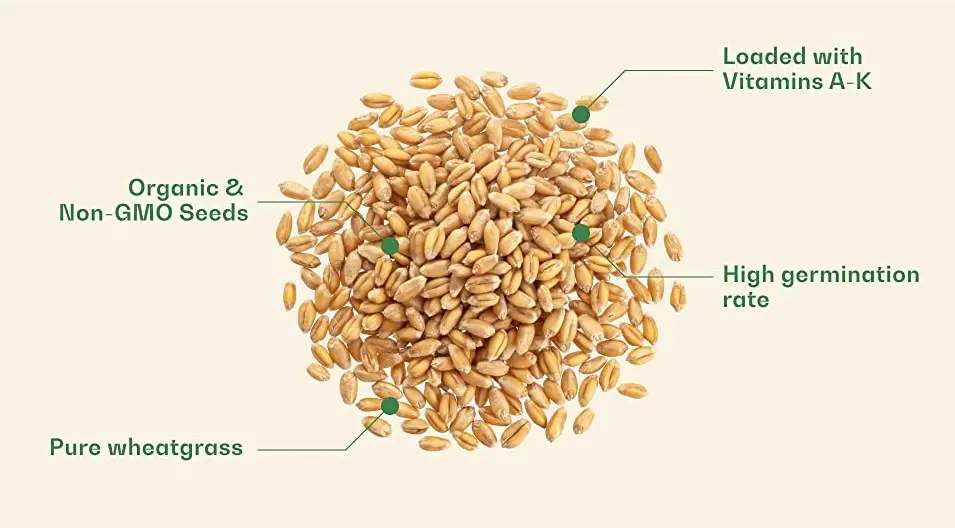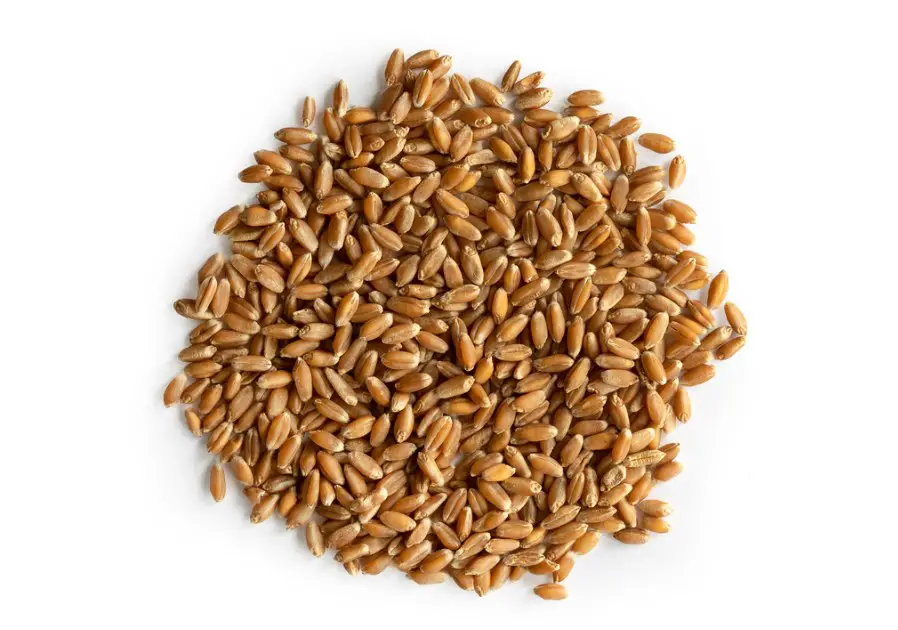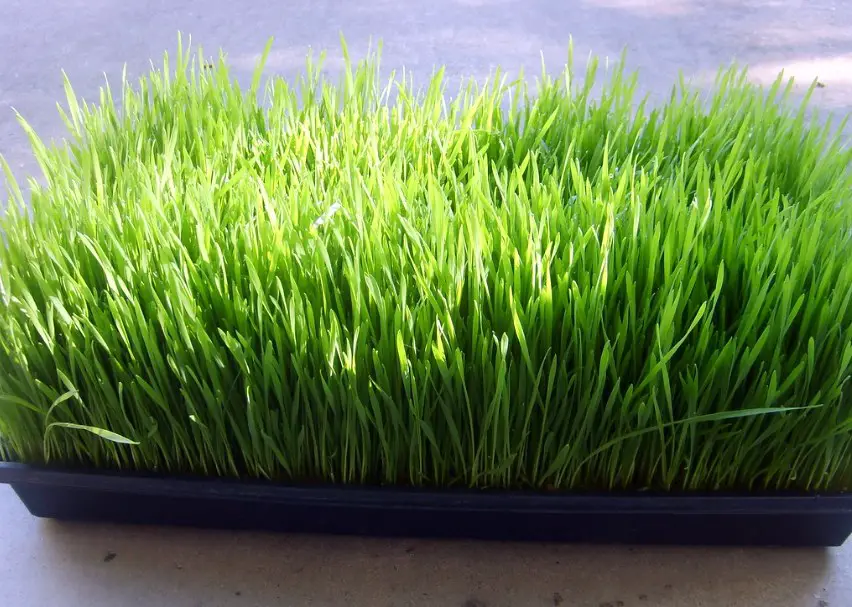It actually may seem it is challenging to grow wheatgrass at home and without soil.
Especially if you know that if you make a mistake, it can kill the plant completely.
However, this article presents some simple steps you can follow and grow wheatgrass without trouble.
Here is the list of things you might need to grow wheatgrass: first of all, buy proper wheatgrass seeds. The recommended ones are winter wheat seeds.
Then you will also need a glass jar or bowl to bed the plant. Other things will include a special bottle with holes, or purchase a spray bottle in the shop. Take baking soda, water, and a kitchen towel as well.
There are differences between growing wheatgrass seeds in the soil and without it. Depending on that, you might need some ground, fertilizers, and a growing tray or a container with holes.
You can actually grow wheatgrass at home if you have wheat seeds, soil, and a container with good drainage.
However, there are numerous other growing medium options available. Using specific treatments to hasten germination can hasten the growth of your grass. Let’s discuss how to grow wheatgrass.

Contents
- 1 Wheatgrass juice
- 2 The benefits of consuming wheatgrass
- 3 Wheatgrass seeds
- 4 Problems with growing wheatgrass
- 5 In soil growing
- 6 Soil or soil alternative?
- 7 How to grow wheatgrass with no soil
- 8 How to grow wheatgrass (conditions to grow wheatgrass at home)
- 9 Storing the wheat grass
- 10 Conclusions
- 11 FAQs:
Wheatgrass juice
Wheatgrass juice has been a staple of juice bars for decades now, having first appeared on their menus in the 1970s.
Wheatgrass juice is made from the newly sprouted, delicate young shoots of the Tritium aestivum plant, which is actually a grass but has health benefits.
You have probably seen small pots of “cat grass” in pet stores, even if you are not the juice bar kind. This is wheatgrass as well, and it is sold for indoor cats to have a snack on when they are craving greenery.
Dogs and cats both consume fresh grass to aid in digestion problems and use other health benefits of it. You may provide your pets with wheatgrass as a secure substitute for turfgrass by growing it at home.

The benefits of consuming wheatgrass
Wheatgrass is rich in iron, calcium, and magnesium and is nutrient-dense and vitamin-packed. It also has a lot of vitamins, especially vitamins A, C, and E, as well as 8 important amino acids, which must be consumed because our bodies cannot make them on their own.
Additionally, it contains several antioxidants, which guard against oxidative stress and cell damage as well as perhaps warding against cancer, heart disease, and other illnesses.
Additionally, it is among the top sources of live chlorophyll: One of the greatest sources is wheatgrass juice, which contains about 70% chlorophyll (as long as it comes from a fresh, living plant).

All green plants contain chlorophyll, which offers numerous health advantages. Inflammation reduction, blood building, energizing, deodorizing, detoxifying, cancer prevention, and other benefits. Actually, the chlorophyll in wheatgrass is what provides the majority of its health advantages.
It may help regulate blood sugar: although, regrettably, research has tended to focus on animals rather than people.
Additionally, raising “good” HDL cholesterol may lower cholesterol.
It may help with weight loss because wheatgrass contains thylakoids, which seem to promote feelings of fullness and satiety by increasing the production of hormones that suppress hunger.
Not to mention that wheatgrass has been used to counteract chemo side effects, slow down the aging process, neutralize toxins, enhance respiratory function (even sinus troubles! ), get rid of acne and scars, soothe a sore throat, keep your intestines “regular,” and more.

How to consume it?
Although wheatgrass can be purchased as a supplement or powder, I will concentrate on the benefits of homegrown wheatgrass.
The most evident one is for your own wheatgrass shots.
However, wheatgrass can also be used to boost the nutritional value of other juices, smoothies, drinks, salad dressings, etc.
Unexpectedly, fresh wheatgrass juice isn’t merely consumed.
You can also add some wheatgrass juice to your bath to cleanse, soothe, and minimize acne and scarring.
Additionally, used externally to soften hands and skin and soothe bites and scrapes.

Own wheatgrass for cats
You were probably cultivating wheatgrass if you’ve ever grown wheatgrass sprouts. Planting wheatgrass, oat grass, barley grass, or any mix of the three, can be used to make grass for cats. Wheatgrass growers use it as dog grass, despite being less prevalent.

Wheatgrass seeds
Although any variety of common wheat (Triticum aestivum) can be used to cultivate a wheatgrass seed, hard winter wheat cultivars are usually the ones that are. Vernalization is necessary for winter wheat to produce seed heads, but not the grass itself.

It is typically preferable to buy wheatgrass-specific seed because it typically has higher germination rates and more health benefits.
Fortunately, buying hard winter wheat is affordable, like this organic non-GMO hard red wheatgrass seed.

Problems with growing wheatgrass
The biggest threat to your plants during the establishing stage is mold and fungus. If the temperature in your growing environment is above 75 degrees, you might want to use a fan to encourage air circulation and prevent the stagnant conditions that might promote the growth of mold or fungus.
When plants are actively growing, if their color changes from green to yellow, it indicates that they require more light, nutrients, or water.
In soil growing
Be aware that this technique only works with planting mixtures that contain soil, compost, or other soil-containing materials.
Fill your growing pot with soil
In the growing container, add one-half to one inch of potting soil to the potting mix; for a 10×10-inch tray, use three to four cups of soil.
Once it’s in the tray, fully wet it without going overboard. You’ve overwatered if there is any water sitting in the tray.
Add wheatgrass seeds
Spread seeds thinly and uniformly over the soil’s surface. To make sure they are completely moist, you might wish to give them one last rinse. Although it is optional, you can gently press the seeds into the soil’s top layer.
Cover with the lid
Darkness is necessary to fool wheat seeds into thinking they are below the soil’s surface. Utilize a cover that offers shade and some airflow. Your container should ideally be placed in a location with bright, indirect light.
To safeguard, humidify, and shade their seedlings, some people decide to cover their containers with a few sheets of moistened newspaper.

How to water wheat seeds?
The seeds should initially be watered twice daily by lightly spraying the top of the soil with a spray bottle. This watering’s goal is to keep the seeds moist, so they can establish their roots in the ground and grow. The most crucial thing is to avoid overwatering, no matter what you do.
Open and wait for wheat grass
In three to five days, when your wheatgrass sprouts are about an inch tall, you can expose them and let them enjoy the benefits of outdoor growth. At this time, the grass will benefit from direct sunlight.
Harvest
Check to see if your wheatgrass plants have “split,” or sent out secondary shoots from the first shoots, as soon as they reach a height of six inches.
The majority of producers discover that after 10 days of growth, their wheatgrass is prepared for harvest.

Soil or soil alternative?
Most of us have some good, sterile potting soil in the shed, and that works just well. It is nutrient-rich and will be a great asset to your grass. Some individuals like to utilize the whole young plant, roots, and all, though. That requires a lot more washing than usual.
However, there are numerous soil substitutes now that will eliminate the need to rinse off stray dirt particles.
Coconut coir allows for good drainage while holding more water than its weight in weight. However, you might need to add additional nourishment in the form of a kelp fertilizer. Coconut coir can also be used without perlite and chemicals.
A nice seed starting medium can also be made by mixing vermiculite with kelp fertilizer. Since vermiculite is a mineral, it doesn’t contain many plant nutrients by itself, but kelp will easily provide all the ingredients for healthy growth.
Last but not least, there are a variety of organic materials that are ideal for producing all kinds of sprouts, microgreens, and grasses.
Overall, the potting mix will provide your grasses with the greatest nourishment, followed by coconut coir and vermiculite.
However, the spread of fungi can be slowed down by using natural textiles.

How to grow wheatgrass with no soil
Be aware that this technique works with soilless growth mixtures like peat moss, coconut coir, or vermiculite.
- Fill your growing container with media
In your growing container, add one-half to one inch of the soil; for a 10×10-inch tray, use three cups of growing material. Coir should already be damp from the process of crushing and soaking it to prepare it and should be moist but not wet. Vermiculite requires one quart of water.
- Plant wheat seeds in the soil
Spread seeds thinly and uniformly across the medium’s surface. To make sure they are thoroughly moist, you might wish to give them one last rinse. Although it is optional, you can gently press the seeds into the medium’s surface.
- Protect the container
Darkness is necessary to fool wheat seeds into thinking they are below the soil’s surface. Use a cover that provides darkness and airflow. Your container should ideally be placed in a space with bright, indirect light and constant room temperature. People decide to place a few damp newspaper sheets over their containers to safeguard and humidify the seeds.
- Watering
A small amount of liquid kelp fertilizer can be added to the water you use to irrigate plants when growing on a soilless medium. In the beginning, you should spritz the top of the soil surface with a spray bottle twice a day to water the seeds.
Watering is done to keep seeds moist, so they can form roots in the soil, get established, and receive some nutrients.
The rest of the stages with waiting and harvesting are similar to the ones described above in the soil growing procedure. See how to grow wheatgrass in the soil section to finish the growing wheatgrass procedure.

How to grow wheatgrass (conditions to grow wheatgrass at home)
Your lawn of wheat grass has been planted! Let’s now discuss how to get the finest growth possible from your little lawn.
Light
Wheatgrass that has already grown needs to be maintained, at least initially, in the dark. This mimics the darkness that exists beneath the soil’s surface. You can remove that cover after three to five days. Your grass ought to be approximately an inch tall by that time. The reason it appears a little pale is that it hasn’t had consistent access to light.
Put your tray in direct, bright light close to a window. It will start to turn green. It’s okay if it receives brief periods of direct sunlight. The intention is to promote that beautiful green color. Mine seems to thrive in bright, indirect light.
You can transfer your tray to a spot where it receives direct sunlight for the majority of the day after a few more days.
Temperature
You need temps between 60 and 75 degrees to start your crop. As a result, growing it indoors is the greatest option, to begin with, because you can keep the ideal range.
Your young grass may endure lower or higher temperatures until it has grown to a height of 1/4′′ to 1/2′′, as long as its roots are comfy. However, it really does like that 60-75 range for the optimum crop. Make sure any covered wheatgrass trays have enough ventilation if the temperature is above 80 degrees to avoid mold or fungi from growing.
Wheatgrass fertilization
You can dilute some little liquid kelp fertilizer in the spray bottle you use to water your wheatgrass to speed up its growth. Although it shouldn’t be used each time you water, it can undoubtedly speed up the growth.

Storing the wheat grass
Make sure wheatgrass is as dry as possible before storing it. Place the bunch into a produce bag with a dry paper towel wrapped over it to absorb extra moisture. So that it doesn’t wilt or spoil, use it as soon as you can.
You can also juice the entire tray and store any extra juice in ice cube trays. You may then add these tiny green cubes to your morning smoothie or glass of fruit juice.
If you’re familiar with wheatgrass powder, you might be interested to learn that a dehydrator can be used to create this useful ingredient at home.

Conclusions
Wheatgrass cultivation is quick and simple, so making a mistake and having to start over isn’t too troublesome. Growing wheatgrass at home should be an enjoyable and fruitful indoor farming experience, whether you’re a die-hard juice enthusiast or you’re just curious about this superfood.
FAQs:
Will wheatgrass regrow after cutting?
After you cut the wheatgrass, it keeps growing, much as your lawn does. Even so, the second cutting reduces the nutritious qualities. Therefore, it is better to just compost the seeds and potting mix before starting a new batch.
How long does it take to grow wheatgrass?
10–14 days before, when you want the plants to be at their best, sow seeds. If you need them to be ready on a certain day, think about seeding a few pots every two or three days, beginning two weeks beforehand. Harvesting. When wheatgrass is about 4″ tall, usually 7–10 days after sprouting, it is ready to be harvested.
Is it better to grow wheatgrass with or without soil?
To grow wheatgrass at home, the more affordable and attractive approach is to grow wheatgrass without soil. However, if a plant doesn’t receive the nutrients it needs from high-quality organic compost, the plant will eventually become deficient in nutrients. Additionally, in terms of the growth process, it is more interactive.
Can you grow wheatgrass in pots?
In a pot with a diameter of 7 inches or numerous smaller pots, one cup of sprouted wheatgrass seeds fills the soil. Pick a container that is between 2-1/2 and 3 inches deep. Wheatgrass should grow in light-weight potting soil (garden soil is too dense).



My cats really love to eat grass, and I often grow wheatgrass at home. But they are sometimes so addicted to eating that they overturn a container of grass and the soil spills out. I didn’t even think that I could grow wheatgrass without soil. But this is a great solution for me! So, I will definitely try. Thanks for the idea!